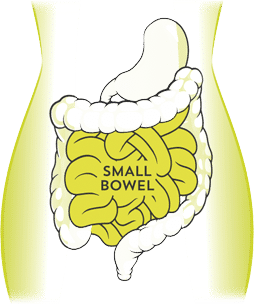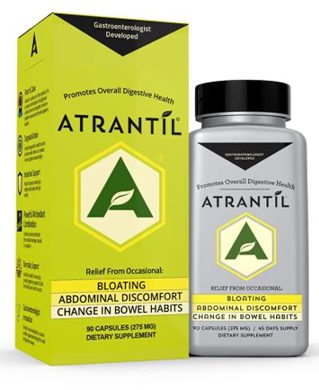Healthcare Professionals
Atrantil has shown significant and drastic improvement in my patient's symptoms, especially for abdominal bloating ...
Tony Macaluso, MD FACS, FASCRS
Colorectal Surgery
Mechanism
Atrantil has a mechanism of action that relieves bloating and abdominal discomfort accompanied by constipation, diarrhea or both by focusing on the duodenum.
Bacteria that are misplaced or overabundant in the small bowel produce free hydrogen as a byproduct, observed as undigested polysaccharide of carbohydrates.
Due to the proliferation of hydrogen, the intraluminal small bowel is an ideal site for archaebacteria and other anaerobic microorganisms.
archaebacteria—a known methanogen in the human gastrointestinal tract—doesn’t belong in the small bowel. Methanogenesis occurs within the archaebacteria via reductase enzyme during cell metabolism, yielding methane as a byproduct.
Methane functions as a mechanical source of intraluminal distension, as well as an attenuator of regular motility.

Atrantil is a unique, patented molecular combination of three natural botanical extracts. The first is a natural antispasmodic, which attenuates contractile responses to acetylcholine, histamine, 5-hydroxytryptamine and substance P.
By reducing calcium influx, the first botanical relaxes the gastrointestinal muscle and slows gastrointestinal motility in the duodenum.
This gives the other two botanical agents more time to act on archaea and bacteria.
The second botanical extract—the flavonoid—begins to form covalent hydroxyl bonds and acts as a hydrogen sink, binding much of the free hydrogen available in the small bowel from misplaced bacteria. (The polyphenolic proanthocyanidins are naturally occurring and condensed. Having two aromatic rings connected by a three-carbon bridge lends in part to the macromolecule benefit of intraluminal action without systemic side effects.)
The archaebacteria require hydrogen for methane synthesis. By binding to the free hydrogen, the flavonoid removes much of the fuel source for methanogenesis.
In addition, the flavonoid binds to and weakens the cell wall of the archaebacteria, disrupting the integrity of the “S” layers of the cell wall making it more susceptible to Atrantil’s third natural botanical extract.
This third botanical—a saponin/flavonoid—performs two functions. First, it kills off the bacteria in the duodenum.
The polycyclic peptide’s amino acids target receptors on the cell wall of the bacteria, and form pores by preventing cell wall synthesis resulting in lysing of the bacterial cell.
Second, the saponin/flavonoid penetrates the cell wall of the archaebacteria compromised by the flavonoid. Once inside of archaea/bacteria, the saponin/flavonoid binds to methyl-coenzyme M reductase halting methane production within the archaea/bacteria itself.
This halts methanogenesis, which reduces the presence of methane in the small bowel and alleviates discomfort caused by methane distension and constipation caused by methane non-absorption.
In summary, Atrantil has three methods of action:
- Killing off bacteria so there’s less hydrogen in the duodenum.
- Using up the available hydrogen through hydroxyl bonds so there’s less hydrogen to be made into methane.
- Shutting down the archaebacteria’s fuel source—thus stopping the ability to produce methane—and killing off the archaebacteria. Through these three actions, Atrantil returns the duodenum to its normal nearly sterile environment and enables the digestive tract to function normally.
Bloating and abdominal discomfort accompanied by constipation, diarrhea or both can be treated in the duodenum.
There are no known systemic side effects when utilizing Atrantil therapy because its natural ingredients are macromolecules, which are intraluminal.
This allows the patient to benefit from a therapy that specifically targets the symptoms of abdominal discomfort and bloating with or without constipation and diarrhea.
A Solution That Does More Naturally
We’ve formulated Atrantil for patients who suffer from bloating and abdominal discomfort accompanied by constipation, diarrhea or both. It’s an effective first-line treatment and a valuable therapeutic option for patients who haven’t found relief with other therapies.
Although Atrantil has no known side effects, we haven’t tested it on pregnant or breast-feeding women. Therefore, we don’t recommend that pregnant or breast-feeding women take Atrantil.
What should patients expect with Atrantil
Atrantil is formulated to address the root cause for bloating and abdominal discomfort accompanied by constipation, diarrhea or both. For most patients, using Atrantil will yield with the most favorable results realized through a regular dosing schedule.
Although there are no known side effects with Atrantil, some patients may experience a Jarisch-Herxheimer reaction, also known as die-off.
Die-off is hypothesized to occur when certain bacteria are lysed and release low levels of an endotoxin.
This process can result in a brief period of low-grade fever, muscle aches or even diarrhea. When seen in patients, this die-off reaction is usually short in duration and a positive sign for several reasons.
The patient will appreciate your recommendation of a non-antibiotic, non-pharmaceutical treatment regimen.
Recomended Dosing

The time required to alleviate symptoms in patients taking Atrantil will vary—dictated in large part by the amount of bacteria present. During clinical studies, some patients were symptom free in as few as two days.
Almost every patient found relief by day 10 of Atrantil therapy with a dosing schedule of two capsules up to three times a day. Just as time to relief can vary, some patients will find control by adhering to a lower or less-frequent dosing schedule.
Dosing
-
Initial Dosing
Begin dosing Atrantil at two capsules three times per day, with each dose taken at the beginning of meals. Most users experience significant relief within 20 to 30 days of starting Atrantil. Some may take longer.
Once relief is realized, consider reducing dosing to two capsules twice daily. If symptoms remain under control, reduce dosing further to two capsules daily.
-
Occasional Bloating
Begin dosing Atrantil at two capsules as abdominal discomfort or bloating symptoms occur or along with foods known to cause symptoms. Most users experience relief in a few hours.
If relief doesn’t occur, consider increasing dosing to two capsules, three times per day, until significant relief is achieved. Reduce dosing as appropriate once relief is achieved and maintained.
-
Maintenance Dosing
After relief is found, maintenance dosing of two capsules daily can protect the environment of the bowel and prevent symptoms.
For known or suspected trigger foods, recommend that patients take one or two capsules before consuming that food.
Safety and Efficacy
The patented formulation of Atrantil comprises three natural botanicals. At the molecular level, Atrantil’s action is intraluminal (minimally absorbed) due to the macromolecular structure.
The side effect profile for Atrantil has been very minimal.
In a small number of patients, we have seen some mild abdominal discomfort when taken on an empty stomach.
Those symptoms resolved when taken with food. If the bacterial load is high, then a possible Herxheimer reaction (die-off reaction) may occur. This causes temporary symptoms such as muscle ache, foggy head, headache, etc.
This is believed to be a sign that Atrantil is working and the reaction is related to the bad bacteria causing a reaction itself.
Clinical Studies and Results

Northwestern University Feinberg School of Medicine Study
This study demonstrated the most ideal test for any over the counter solution regarding health issues such as bloating or associated gastrointestinal methane problems. First, the results demonstrated that 56% of all participants experienced adequate relief. Those results were measured against SEVEN categories of suffering. Second, this was a 100% independent, major university medical school test constructed without bias. Third, essentially there were no exclusionary criteria for participants. These are serious parameters for any solution to meet a challenge and Atrantil more than met expectations. The integrity of the design was trusted to a worldwide recognized leader in gastroenterology, the Principal Investigator, Darren Brenner, MD, FACG, AGAF, RFF. Dr. Brenner is a professor of medicine and surgery, an IDP Foundation Research Scholar, and the director of the Northwestern University Neurophysiology Program.
None of KBS Research, LLC and all associated partners had any influence, monetary or otherwise, regarding the study design, product acquisition, or analysis of results.

Double-Blind Study
In a double-blind clinical study of patients suffering from bloating, constipation and abdominal discomfort, Atrantil proved to be more than 88 percent effective in relieving symptoms. The results of the study were published in the Journal of Gastroenterology and Hepatology Research – September 21, 2015 pp. 1762-1767.

Open-Label Study
The open-label study targeted the toughest-to-treat patients to illustrate the efficacy of Atrantil. Before beginning the study, patients qualified to participate only after failing to find relief from at least four other therapies. The trial showed that 80 percent of patients found relief after using Atrantil to control their bloating, constipation and abdominal discomfort. The results of the study were published in the World Journal of Gastrointestinal Pharmacology and Therapeutics – August 6, 2016 pp. 463-468.
For More Information
If you’re ready to give your patients the latest in efficacy and safety for bloating and abdominal discomfort accompanied by constipation, diarrhea or both, the Atrantil team’s here to help.
Request a physician kit now. And to schedule an in-person office visit or get answers to your questions, please contact:
Healthcare Concierge Hcp@atrantil.com 214-984-3724 ext. 708
These statements have not been evaluated by the Food and Drug Administration. This product is not intended to diagnose, treat, cure or prevent any disease. Individual results may vary.
